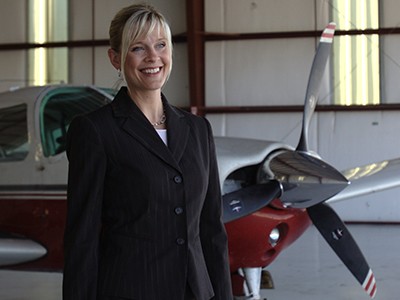Taking a Country's 'Temperature'
Jeannie Johnson, an assistant professor of political science, is the recipient of a $100,000 grant from U.S. intelligence agencies to teach analysts a pioneering methodology for obtaining information about foreign countries.
Jeannie L. Johnson, an assistant professor in political science, can’t talk much about her new federal grant.
Suffice it to say that it will help U.S. intelligence agencies better evaluate the future of nuclear weapons in our uncertain world.
The grant is titled “A Cultural Approach to Assessment of Nuclear Intentions of Over-the-Horizon Countries” meaning those nations that don’t yet have nuclear aspirations.
“Here’s the problem,” said Johnson, “once countries begin to engage in that active dialogue and make a political decision to go after nukes, our experience is that the United Sates has almost no leverage after that point.”
Such an over-the-horizon country may be, for instance, somewhere like Ukraine or Turkey. We don’t know for sure, however, because that’s classified. Johnson’s methods, however, are not.
Johnson, who began as a lecturer at USU in 1999 and moved to a tenure track in 2013, is an expert in strategic cultural analysis. She’s long served as a consultant for the U.S. Department of Defense and the 17 agencies that make up the U.S. intelligence community. She pulls from her experience as a former CIA intelligence officer and a political officer in the U.S. embassy in Zagreb, Croatia.
Nearly a decade ago, she began to develop, along with CIA Assistant Director for Global Issues Matt Berrett, a pioneering methodological tool that gives analysts a clearer window into a specific culture, whether it’s a country or an organization. In use since 2008, this tool, called “cultural topography” and “cultural mapping,” has proven to be effective in “taking a country’s temperature,” she said.
The $110,000 grant will allow her to teach the methodology to intelligence analysts who are following the nuclear ambitions of specific countries.
“We recognized that one of the things the intelligence community was missing was a focus on culture — understanding a country’s habits, mindset, perceptual lens and their experience,” she said.
Instead, American intelligence gatherers have long relied on clandestine operatives or “mirror imaging” — that is, foreign cultures were evaluated only through our unique American ideals.
“The leading paradigms of my field …validate this approach by saying that all nations are driven by a universal rationality and that all nations pursue wealth and power,” she said.
Unfortunately, this approach doesn’t work well when dealing with nations like, say, North Korea.
Cultural topography looks at “intentionality” — using culture as a lens to understand a nation’s motives.
“Here’s the conundrum that not many Americans know,” said Johnson. “There are so many countries that are capable of building nuclear weapons and choose not to. That’s the interesting question.”
Cultural mapping methodology first targets the group or issue most influential in any future consideration of nuclear weapon. It may be scientists, said Johnson, or the military, or even the general population. The template focuses on four angles:
1. Identity, or how a country sees itself.
2. Values — not only values like truth or goodness, “but what genuinely enhances one’s status” in the target population, she said. This may be family name, ethnic heritage or business success.
For instance, U.S. officials in the Middle East mistakenly used the phrase “moderate Muslim” as a compliment, she said.
“For us, moderate simply means you’re not a violent extremist,” she said. “But when we call leaders ‘moderate Muslims’ in public, we absolutely undermine their credibility with their own people.”
3. Norms, or accepted modes of behavior.
4. Perceptual lens — understanding what a group considers to be credible sources of information. “What explains the way their world has developed up to this point — is this human determination? Is it fate?” she said. “We need to understand the forces at work.”
This was especially true in recent negotiations with Iran. Americans, for example, strongly value timeliness, Johnson said. Set a deadline, and Americans will strive to achieve it.
Iranians, on the other hand, “have nothing like that value structure,” she said. “Nowhere in their culture is meeting an arbitrary deadline venerated.”
So while Americans need the satisfaction and closure of a deadline, she said, “The Iranians are like, ‘Who cares? We’re still talking, aren’t we?’”
If we understand those complexities, she said, “we’re able to anticipate and avoid things like, for instance, making statements that box us in. “
Johnson describes cultural topography as a tool that gives analysts a set of questions to “research different veins of research than our community has traditionally done.”
In tests since it was adopted in 2008, the methodology has been received with praise and appreciation, said Johnson. “It’s information that isn’t traditionally passed forward by the intelligence community,” she said. “It’s really useful for navigating your relationship with another country.”
To identify the “cultural temperature” of a country, cultural topography uses data already available — analyzing public speeches, for example, or political cartoons to see who’s being lampooned. “Most of what we’re collecting isn’t secret. It’s just not well understood,” she said.
The next step for Johnson is to work with experts in specific countries — their names to remain anonymous, of course — to teach the methodology. In this 2017 round, the focus will be on two countries. Previously, she said, eight countries were analyzed. This time, “we wanted to drill deeper and give more time and resources to just those couple of countries.”
Johnson also uses the same methodology in her career-long study of the singular culture within the Marines. Her next book, The U.S. Marine Corps and the Problem of American Counterinsurgency, is forthcoming in 2017 from Georgetown University Press.
Additional links:
USU Department of Political Science
CIA’s own analysis of the program
Writer and contact: Janelle Hyatt, 435-797-0289, Janelle.hyatt@usu.edu
Comments and questions regarding this article may be directed to the contact person listed on this page.






